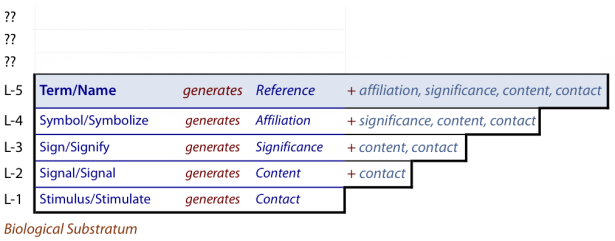Terms: Wrap it Up at L5
Function & Name
is the THEE-name for: «something that is used to make specific reference to an object of experience—outer, inner, imaginary or virtual—with the aim of using it in a social context.»
The receiver may view things as in the same manner.

«» can also be used to refer to the process (i.e. it is also a verb, «», but «terming» is rarely used in English). I much prefer: and for the thing: Also possible, are: & . Both of these alternative names may be used at times within TOP instead of «».
Properties
must discriminate entities so we can refer to different things easily. The commonest form of is verbal i.e. words; but can also occur via visual shapes. As a result, mathematical symbols or chemical formulae can also serve as . Touch patterns, sound harmonies or melody also can be used. However, stimuli like smells, tastes and pain do not possess the necessary discrimination for .
Both parties to any must have an appropriate exposure in regard to in order to know what they refer to. are therefore intrinsic to socialization, literacy, education and human interaction. So uneducated and socially deprived people may have a rather limited vocabulary of .
categorize and discriminate within a social group to serve the group's purposes. Social groups unhesitatingly generate and accept new if they meet their own needs (e.g. academics, ghetto inhabitants, users of THEE, are all preoccupied with using the right ).
However, , as words, can be slippery things — they are not easily tied down to just one reference. Read more about words.
may be used sloppily due to carelessness, or with a lack of discrimination due to not seeing or knowing.
In addition, errors typical of lower Level forms may all occur e.g. a might not be learned (like a ); or might not be understood (like a ).
have an ability to «capture meaning» based on discrimination amongst things or categories of things. Dictionaries and glossaries take on their most useful and complex forms in relation to verbal terms: not only explaining but seeking origins (etymology), and providing synonyms and antonyms (thesaurus). Note that similar compilations can be developed at all lower Levels except which are infrastructural for .
The complexities of reference and discrimination provide the basis for semantics within any language. are certainly intrinsic to language. However, from a practical (i.e. THEE) perspective, the essence of language does not lie in themselves, but in the uses to which are put during any .
To express ourselves, understand others, and generally make things happen, language also requires:
- syntax indicating how words need to be ordered
- pragmatics relating to the effects of using language
It is evident that the and related matters are not handled at (or at lower Levels).
At in , we suddenly come upon the mechanism necessary for language. discriminate objective and subjective entities and lend themselves to manipulation. But how, where and to what end?
are the culmination of a steady but discontinuous hierarchical increase in potential for . Yet nothing so far deals with thinking or even the articulation of a simple factual statement, both of which require language. Something more powerful and intrinsic to is evidently required to enable .
- Continue to the two highest Levels that determine how these 5 Levels of elements are handled. Start with L6.
Originally posted: 18-Apr-2011; Last updated 25-Sep-2011.